Apache ShardingSphere can encrypt the plaintext by parsing and rewriting SQL according to the encryption rule, and store the plaintext (optional) and ciphertext data to the database at the same time. Queries data only extracts the ciphertext data from database and decrypts it, and finally returns the plaintext to user. Apache ShardingSphere transparently process of data encryption, so that users do not need to know to the implementation details of it, use encrypted data just like as regular data.
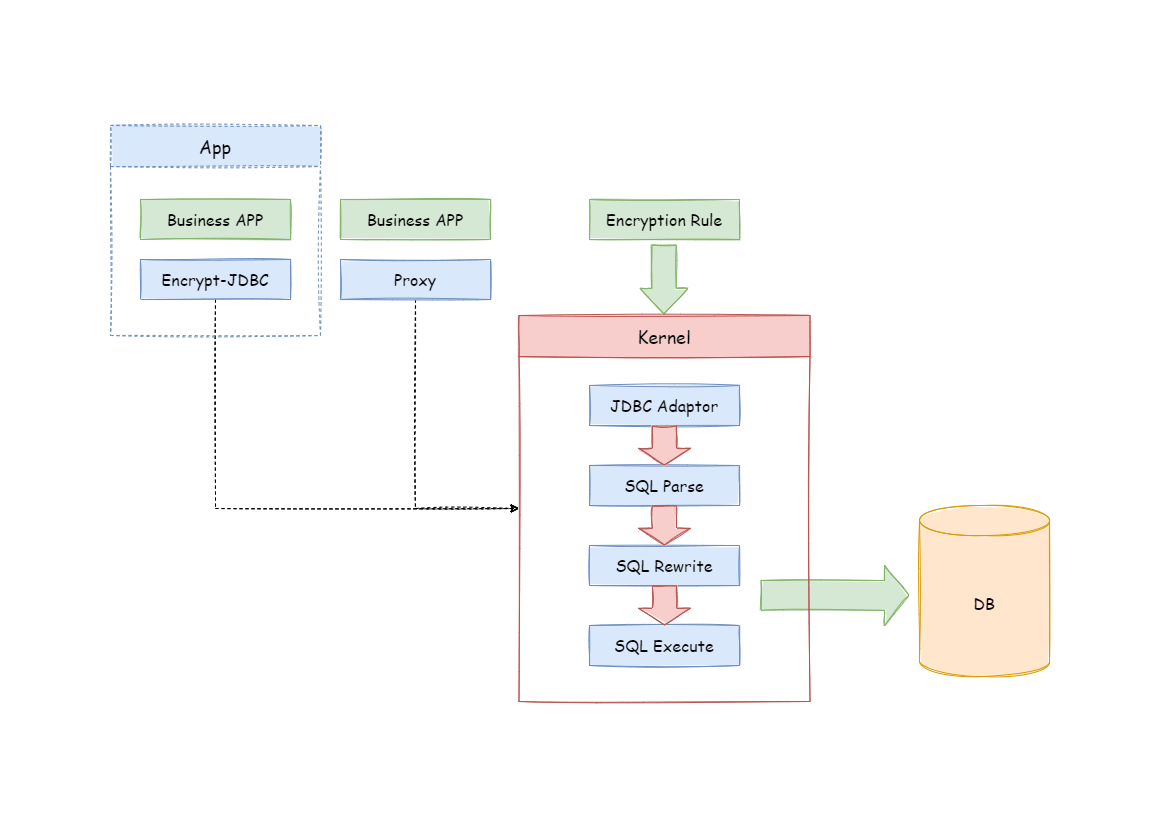
Encrypt module intercepts SQL initiated by user, analyzes and understands SQL behavior through the SQL syntax parser. According to the encryption rules passed by the user, find out the fields that need to be encrypted/decrypted and the encryptor/decryptor used to encrypt/decrypt the target fields, and then interact with the underlying database. ShardingSphere will encrypt the plaintext requested by the user and store it in the underlying database; and when the user queries, the ciphertext will be taken out of the database for decryption and returned to the end user. ShardingSphere shields the encryption of data, so that users do not need to perceive the process of parsing SQL, data encryption, and data decryption, just like using ordinary data.
Before explaining the whole process in detail, we need to understand the encryption rules and configuration, which is the basis of understanding the whole process. The encryption configuration is mainly divided into three parts: data source configuration, encrypt algorithm configuration, encryption table rule configuration. The details are shown in the following figure:
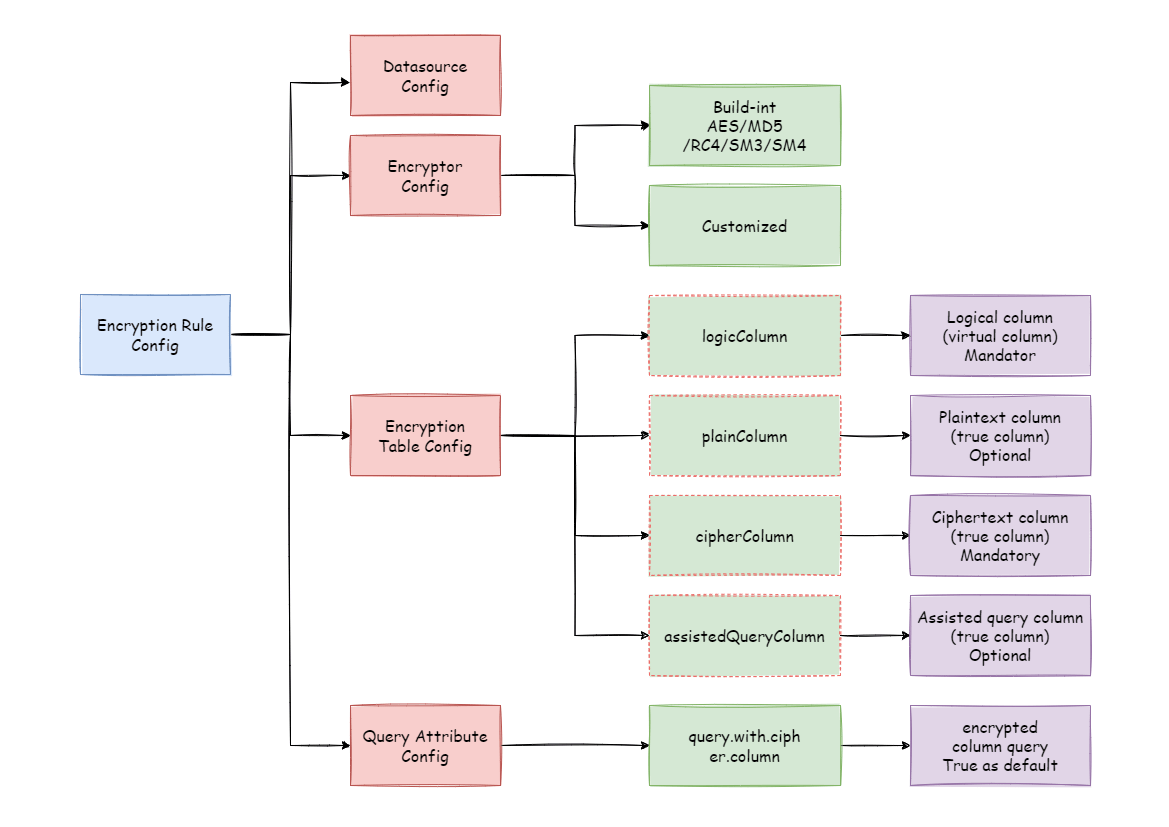
Datasource Configuration:The configuration of DataSource.
Encrypt Algorithm Configuration:What kind of encryption strategy to use for encryption and decryption. Currently ShardingSphere has three built-in encryption/decryption strategies: AES, MD5, RC4. Users can also implement a set of encryption/decryption algorithms by implementing the interface provided by Apache ShardingSphere.
Encryption Table Configuration:Show the ShardingSphere data table which column is used to store cipher column data (cipherColumn) and which column users want to use for SQL writing (logicColumn)
How to understand
Which column do users want to use to write SQL (logicColumn)?We have to know first why the encrypted module exists. The goal of the encrypted module is to shield the underlying data encryption process, which means we don’t want users to know how data is encrypted and decrypted, and how to store ciphertext data into cipherColumn. In other words, we don’t want users to know there is a cipherColumn or how they are used. Therefore, we need to provide the user with a conceptual column that can be separated from the real column in the underlying database. It may or may not be a real column in the database table so that users can change the column names of cipherColumn of the underlying database at will. The only thing we have to ensure is that the user’s SQL is written towards the logical column, and the correct mapping relation between logicColumn and cipherColumn can be seen in the encryption rules.
Why do you do this? The answer is at the end of the article, that is, to enable the online services to seamlessly, transparently, and safely carry out data encryption migration.
For example, if there is a table in the database called t_user, there are actually two fields pwd_plain in this table, used to store plain text data, pwd_cipher, used to store cipher text data, and define logicColumn as pwd.
Then, when writing SQL, users should write to logicColumn, that is, INSERT INTO t_user SET pwd = '123'.
Apache ShardingSphere receives the SQL, and through the encryption configuration provided by the user, finds that pwd is a logicColumn, so it decrypt the logical column and its corresponding plaintext data.
As can be seen that ** Apache ShardingSphere has carried out the column-sensitive and data-sensitive mapping conversion of the logical column facing the user and the plaintext and ciphertext columns facing the underlying database.
As shown below:
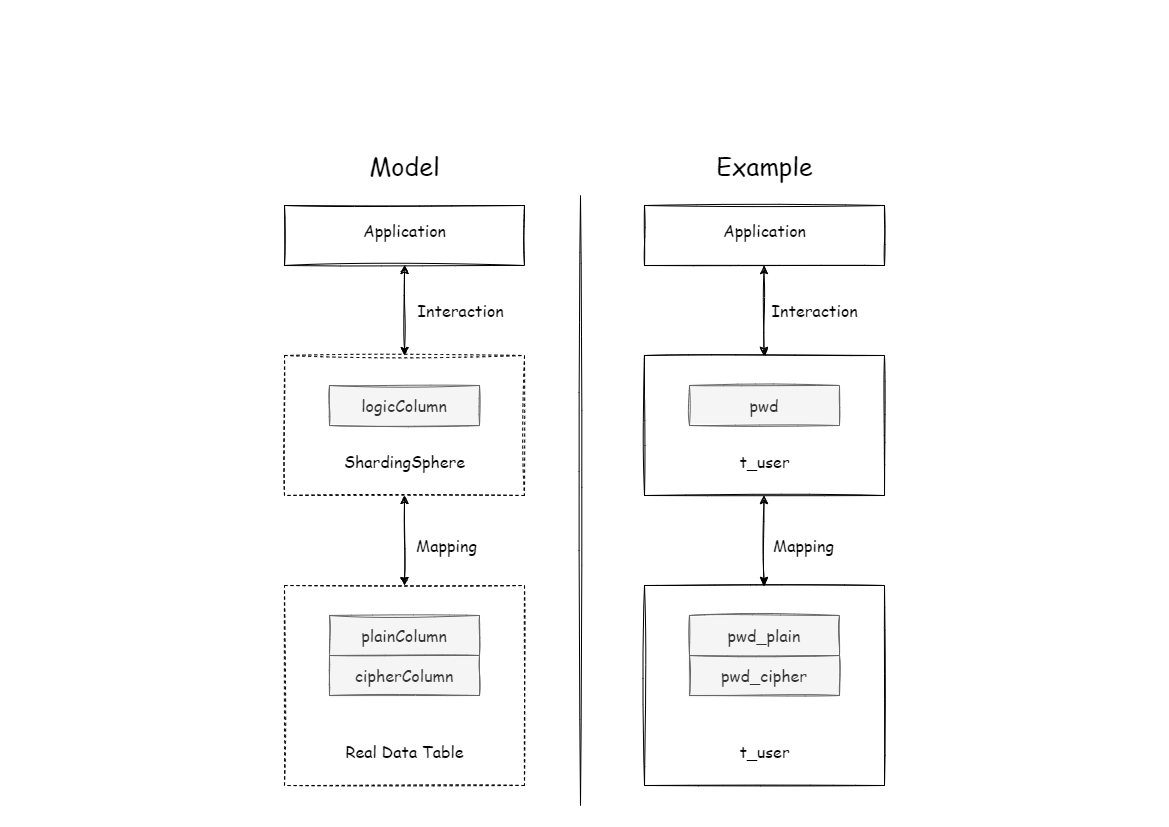
This is also the core meaning of Apache ShardingSphere, which is to separate user SQL from the underlying data table structure according to the encryption rules provided by the user, so that the SQL writer by user no longer depends on the actual database table structure. The connection, mapping, and conversion between the user and the underlying database are handled by Apache ShardingSphere. Why should we do this? It is still the same : in order to enable the online business to seamlessly, transparently and safely perform data encryption migration.
In order to make the reader more clearly understand the core processing flow of Apache ShardingSphere, the following picture shows the processing flow and conversion logic when using Apache ShardingSphere to add, delete, modify and check, as shown in the following figure.
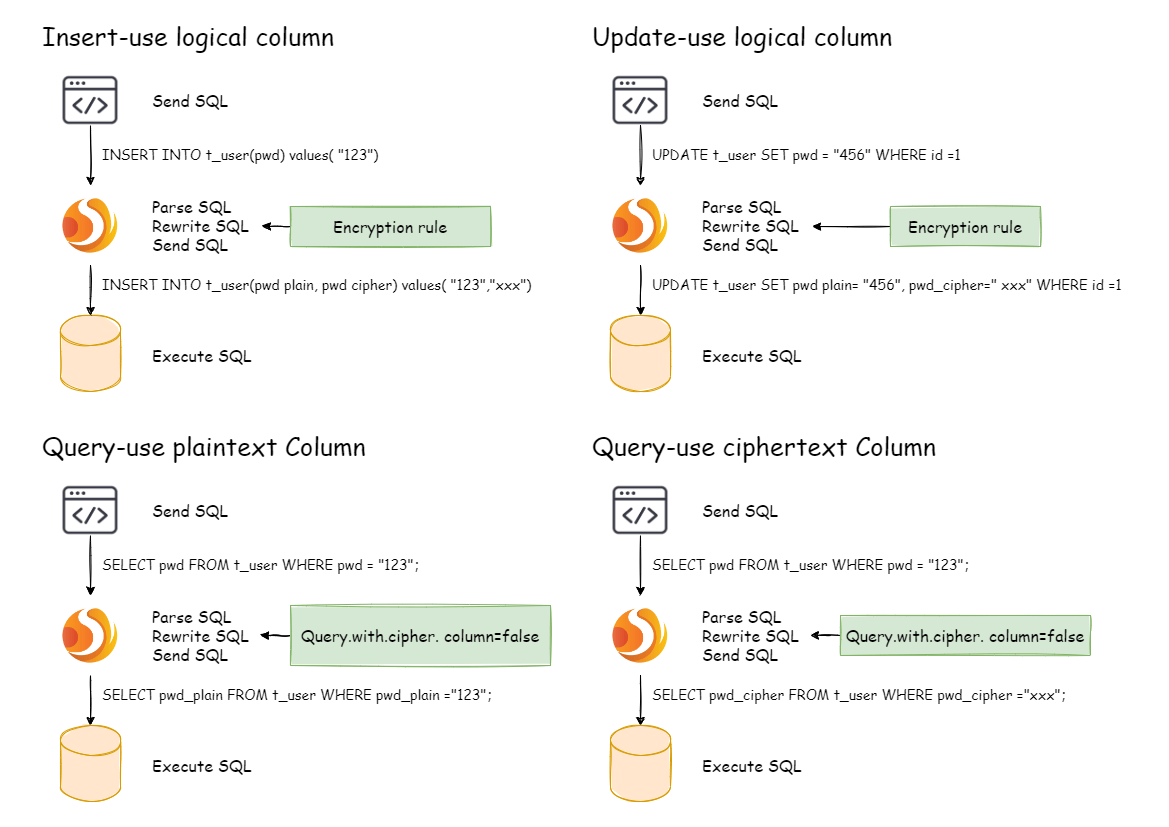
After understanding the Apache ShardingSphere encryption process, you can combine the encryption configuration and encryption process with the actual scenario. All design and development are to solve the problems encountered in business scenarios. So for the business scenario requirements mentioned earlier, how should ShardingSphere be used to achieve business requirements?
Business scenario analysis: The newly launched business is relatively simple because everything starts from scratch and there is no historical data cleaning problem.
Solution description: After selecting the appropriate encrypt algorithm, such as AES, you only need to configure the logical column (write SQL for users) and the ciphertext column (the data table stores the ciphertext data). It can also be different **. The recommended configuration is as follows (shown in Yaml format):
-!ENCRYPT
encryptors:
aes_encryptor:
type: AES
props:
aes-key-value: 123456abc
tables:
t_user:
columns:
pwd:
cipherColumn: pwd
encryptorName: aes_encryptor
With this configuration, Apache ShardingSphere only needs to convert logicColumn and cipherColumn. The underlying data table does not store plain text, only cipher text. This is also a requirement of the security audit part. The overall processing flow is shown below:
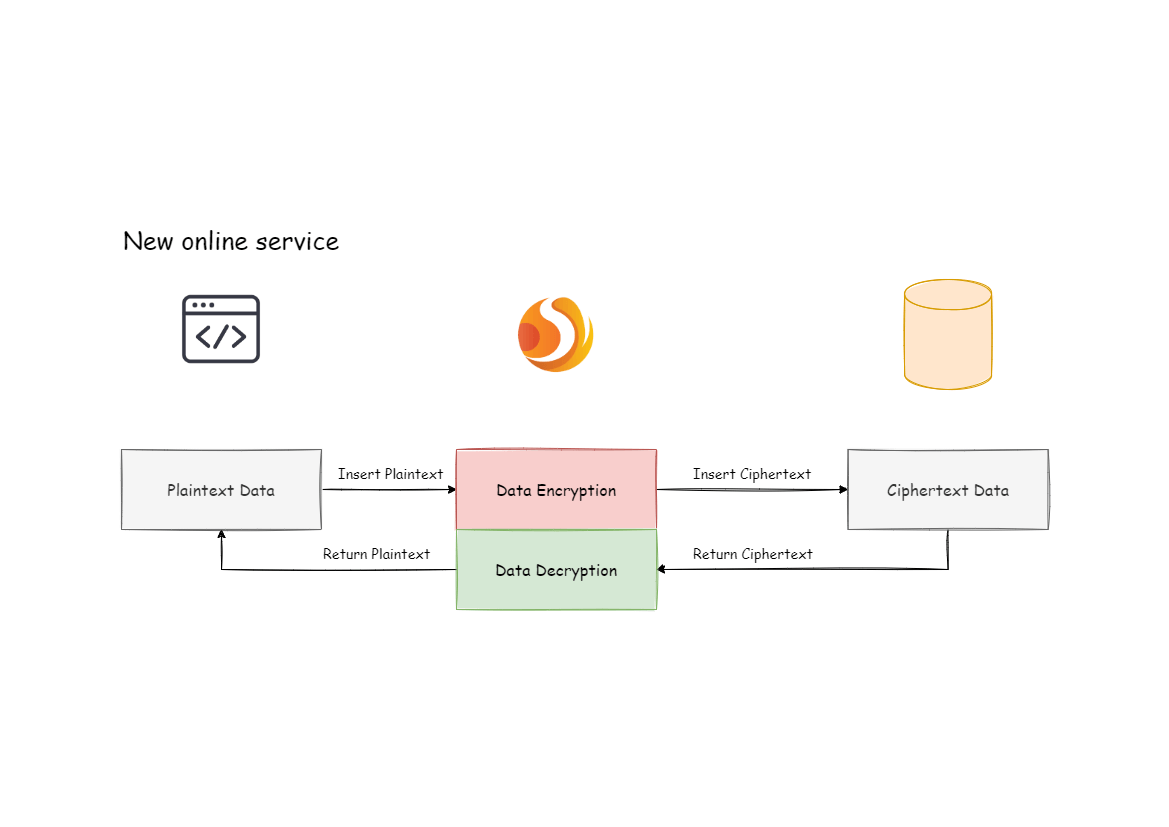
Apache ShardingSphere has provided two data encryption solutions, corresponding to two ShardingSphere encryption and decryption interfaces, i.e., EncryptAlgorithm and QueryAssistedEncryptAlgorithm.
On the one hand, Apache ShardingSphere has provided internal encryption and decryption implementations for users, which can be used by them only after configuration. On the other hand, to satisfy users’ requirements for different scenarios, we have also opened relevant encryption and decryption interfaces, according to which, users can provide specific implementation types. Then, after simple configurations, Apache ShardingSphere can use encryption and decryption solutions defined by users themselves to desensitize data.
The solution has provided two methods encrypt() and decrypt() to encrypt/decrypt data for encryption.
When users INSERT, DELETE and UPDATE, ShardingSphere will parse, rewrite and route SQL according to the configuration. It will also use encrypt() to encrypt data and store them in the database. When using SELECT,
they will decrypt sensitive data from the database with decrypt() reversely and return them to users at last.
Currently, Apache ShardingSphere has provided three types of implementations for this kind of encrypt solution, MD5 (irreversible), AES (reversible) and RC4 (reversible), which can be used after configuration.
